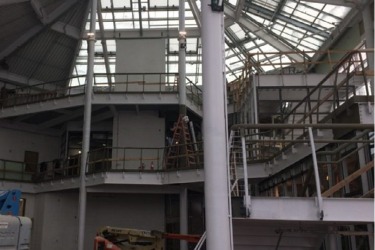Of all building materials, none have the range and versatility of steel. Like stone and concrete, it has tremendous compressive strength and can be formed into nearly any shape. Like wood, it has tensile strength to support pressure and movement without breaking. In many applications, it’s better than stone, concrete and wood as a building material in that it weighs much less for the amount of force it can withstand. Given equal dimensions and conditions, wood and concrete will crack under stress long before steel would begin to deform.
WHAT IS STRUCTURAL STEEL
Structural steel comprises steel beams and columns used as the primary structural elements in an edifice. Used to form the skeleton, it supports all the other building components. Light gauge, cold-formed steel used in framing low-rise buildings and houses could be considered “structural” steel in as much as it forms the armature of the construction project. However, in architectural engineering, structural steel indicates hot-rolled, much stronger and heavier steel than light gauge. When the edifice is meant to support hefty burdens of concrete and substantial live loads, only hot-rolled structural steel will fit the bill.
WHY STRUCTURAL STEEL WORKS WELL IN COMMERCIAL CONSTRUCTION
Because structural steel can be rolled into many different shapes, it is perfect for a huge variety of commercial construction designs. Its durability has been well proven, as you can tell by the Eiffel Tower, Golden Gate Bridge and skyscrapers, such as the Flatiron Building, built over a century ago. Since columns and beams fasten together relatively easily with bolts and welds, structural steel makes for an excellent building material for large, complicated projects that must be pieced together at heights.
Some of those projects include the following:
1. High-rise Office Buildings
The tensile weight-to-strength ratio of structural steel makes high-rise towers possible. Before the advent of this special iron product, building heights were regulated by how much vertical load concrete or masonry could withstand. While some impressive heights could be achieved, no structure approached the altitude of any modern skyscraper. Additionally, because the inherent properties of the steel enable it to bend under seismic and wind shears, steel construction in areas prone to earthquakes, tornadoes and hurricanes only makes sense, even in low-rise buildings.
2. Multi-Family Housing
Erecting apartment buildings and condos can be done more economically with structural steel than with concrete. With less weight in the columns and girders, the building contractor can save on foundation costs. Also, steel members join together quickly, saving considerably on project time and labor costs.
3. Bridges and Overpasses
With its superior tensile strength, structural steel makes large bridge spans possible with fewer vertical supports, freeing up the ground or water below for traffic lanes. Better yet, steel withstands the constant vibration of traffic on the bridge, flexing where masonry or concrete would not.
4. Factories
Because steel allows for much larger spans between supports, factories benefit from this feature. Since factories often need large, unobstructed space for machinery, steel allows more efficient production layouts and accommodates movement of bulk materials.
5. Warehouses
Like factories, warehouses see a lot of action under the roof. Steel construction facilitates high roofs and a lot of clear floor space to move goods around with forklifts and trucks.
6. Large Auditoriums
With steel, creating unobstructed views of the stage presents little difficulty to designers of large auditoriums. For the same reasons steel serves factories and warehouses, it also works well for convention centers, theaters and symphony halls. Steel also easily supports elevated tiers of seating with less overall material.
7. Stadiums
Fans of professional sports appreciate structural steel, especially when they can comfortably attend live football games in the midst of winter. The large, covered stadiums that house football fields, seating for upwards of 70,000 people plus all of the vendors and service bays are made possible by structural steel.
Framing with structural steel involves working closely with the fabricator. Serving the Colorado Front Range, Barton Supply has everything needed to fabricate and deliver structural steel to your project, however large or small.
